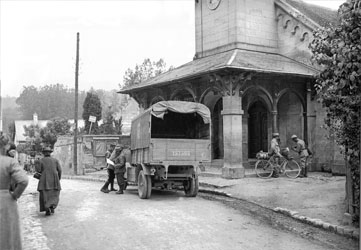


| A la une |
|---|
| La Forêt |
| Liens |

Discovering Vieux-Moulin
in the heart of the Forest of Compiègne
The village of Vieux-Moulin is located 55 miles north of Paris in the forest of Compiegne. It is half way between the cities of Compiegne and t Pierrefonds. Vieux-Moulin is a community of 626 inhabitants in the region of Hauts-de-France.
The village is essentially resisidential with the population being primarily professionnal. A large percent of the people work either in Compiegne or in the Parisian district. Many tourists visit the the forest of Compiegne during the summer months and on week-ends. The area around Vieux-Moulin is rich in history with an abondance of medieval castles and churches.
The history of France has always been present in Compiegne throughout the centuries. The rulins of the Roman conquest can been seen, as well as the royal and imperial residences of Louis XIV and Louis XV, Napoleon I and Napoleon III - The Armistice of World War I was also signed in the forest of Compiegne, and an important museum has been constructed on this site.

The Town Hall of Vieux-Moulin
In March of 2014, Mrs. Béatrice Martin was elected mayor of Vieux-Moulin. The municipal team is made up of three deputies and eleven counselors.
Madam Mayor flanked by her deputies.

The church of Vieux-Moulin
Left: Thursday, June 13, 1918, French civilians and soldiers in front if the church in Vieux-Moulin...five months before the Armistice.
Right: Saint-Mellon church in 2016.
The church is dedicated to Saint Mellon, bishop of Rouen from 261 to 311, and celebrated on October 22nd. He is also the patron saint of Pontoise.
At the beginning of the 19th century, Philippe le Bel awarded the chapel of Vieux-Moulin to the Abbey of Royalieu. In 1814 the church was burned down by Russian Cossacks and would remain unused for 40 years.
The alliance of the Catholic church with the Second Empire was very profitable to the Church in the second half or the 19th century. In 1859 it was decided that the church of Vieux-Moulin would be restored.
The "restoration" in 1860 is confirmed by the following inscription in the rood screen of the church:
"n the Year of Christ 1860, the Emperor Napoleon III ordered the reconstruction, at his expense, of this sacred house".
Jean-Louis Victor Grisart was the architect of the reconstruction.

Antiques and Flea-Market
Every year, on the first Sunday of September, the Vieux-Moulin flea-market takes place, organized by the Festival Committee.
Two hundred inhabitants of the village come to sell items that are cluttering up their homes, and buyers come from all over the region and even from the Paris region to find that rare object.

The Vieux-Moulin elementary school
In 2016, 70 students are enrolled at Vieux-Moulin. Secondary education takes place in the junior high- and high-schools in Compiègne.

Claudette's Grocery Store
Claudette's grocery/restaurant is located on Saint-Jean street.
The Daguet Inn
The Daguet Inn is located across the street from Saint Mellon church.
The Mont Saint-Pierre Inn
The Mont Saint-Pierre restaurant is located on the rue des étangs at the end of Vieux-Moulin.

The houses of Vieux-Moulin
There is no "historical monument" in Vieux-Moulin, but it is located in an exceptional setting!
The village of Vieux-Moulin was formerly populated by loggers and farmers. In the 18th century there were 77 houses, built of wood, with mud walls, thatched roofs, and earthen floors..
The oldest of today's houses date back to the middle of the 19th century, and are mostly built of stone from the quarries of Mont Saint-Mard near the village.
At the end of the 19th century, with the arrival of the railroad, and at the beginning of the 20th, with the development of the automobile, Vieux-Moulin became a holiday destination for tourists, mostly from the Paris region.

Saint Peter's ponds
Left: Emperor Napoleon III had the structure of the ponds modified in 1859. The Rouillie, Agneau, and Neuf ponds were combined to form the Saint Peter's pond, while the Saint-Peter and Mayette ponds were combined to form the Rouillie pond, five of the seven ponds that the Celestin monks of the Mont Saint-Pierre dug during the middle ages. The ponds served as fish ponds to feed the monks. .
Right: The former guardian's house was modernized in 1857 by the architect Jean-Louis Victor Grisart at the request of Napoleon III.
(He also built the church in Vieux-Moulin). The pavilion was notably used by Empress Eugenia when she visited the restoration works at the Chateau of Pierrefonds. Today it is called the Eugénie Pavilion.

Mount Saint-Pierre
or Saint-Pierre in Chastres

Saint-Perre Castres is a gap to the southwest of Vieux-Moulin. The Mont Saint-Pierre is at an elevation of 450 ft, and is located near the Etot pond, 3 miles from Vieux-Moulin.
During the 17th century the Celestins were replaced by the Benedictins, and the décor of the church choir dates back to this period as does the pavilion itself, which according to the inscription placed by the fireplace was built in 1664. It was the prior's residence, and also served as a guest house. The library kept its coffered ceiling and door frames painted with rural scenes. The stairway has a shaded ramp.

Vieux-Moulin is halfway...
Between the Imperial Palace of Compiègne
Compiègne, royal and imperial residence, 6 miles from Vieux-Moulin.
...and the Chateau of Pierrefonds
The Chateau of Pierrefonds was restored in 1857 by Eugène Viollet-le-Duc, and is located 4 miles from Vieux-Moulin.



























